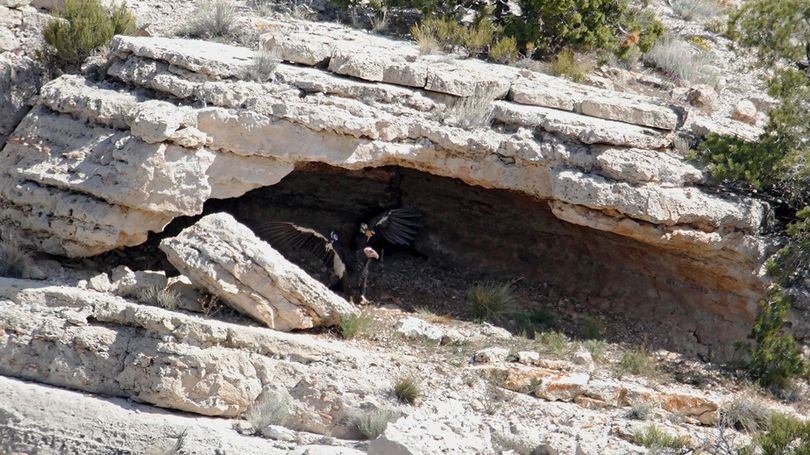Pioneering condor chicks soaring in Grand Canyon

ENDANGERED SPECIES -- Two of three California condor chicks that hatched in the Grand Canyon of Arizona earlier this year are doing well, including one that recently took its first flight from the nest.
The other surviving chick is flapping its wings and hopping around its cliff-cave nest, indicating it's ready to fledge, too.
The third chick recently perished, possibly from a fall from the nest, but not before the three chicks and their parents set milestones for recovery of the endangered species:
- The greatest number of chicks hatched in the wild in one breeding season since the effort to recover endangered condors in the Grand Canyon region began in 1996.
- The first time during recovery efforts that three chicks were producedin the wild in a single season.
"We remain hopeful that the two remaining chicks will join the ever-growing flock," said Eddie Feltes, field manager for The Peregrine Fund, an Idaho-based conservation organization that oversees the condor recovery program in Arizona and southern Utah.
Read on for more details.
The young bird that died had a broken wing and may have fallen from its nest, but due to the condition of the carcass, examiners were unable to pinpoint a cause of death.
The young condor was last seen alive on Sept. 27. After Grand Canyon National Park biologists made several investigative trips into the rugged terrain of a side canyon, the carcass was recovered on Oct. 23.
Recent sightings of the two other wild-hatched juveniles show that they continue to thrive and be well cared for by their parents. Three adult birds are tending the fledgling, which took its first flight from its nest in the Kaibab National Forest in late October. This is the first time that a trio has successfully produced a fledged chick in the wild.
The other remaining chick is expected to fledge soon as well. National Park Service biologists are monitoring its nest cave in the Grand Canyon.
"The surviving chick in the park appears to be close to making its first flight," said Martha Hahn, chief of Science and Resource Management at Grand Canyon. "Park wildlife staff have observed the chick flapping its wings and hopping around, which is typical behavior of condor chicks before fledging."
The carcass of the dead chick was sent to the San Diego Zoo Institute for Conservation Research. Besides the broken wing, pathologists identified small bits of trash in the condor's stomach, but the foreign items appeared to be incidental.
The presence of tiny pieces of metal, plastic, and other indigestible material in the bird's stomach is not that unusual for scavengers found near areas where people live or visit.
"We have found foreign items in and around other condor nest caves in the Grand Canyon and the chicks fledged without issue," said Chris Parish, director of The Peregrine Fund's condor recovery program in Arizona. "This event does, however, demonstrate the volume of trash that exists in the environment, and we can all help by packing out what we pack in."
Even the smallest bits of trash can be mistaken for food items, he said.
"Because microtrash has been such a problem with fledglings in California, we are forever on alert," Parish said.
The condor recovery effort is a cooperative program by federal, state, and private partners, including the Arizona Game and Fish Department, U.S. Fish and Wildlife Service, Bureau of Land Management, National Park Service, Utah Division of Wildlife Resources, Kaibab and Dixie national forests, and Zion National Park.
